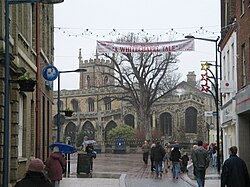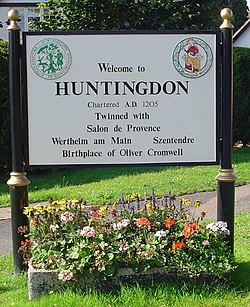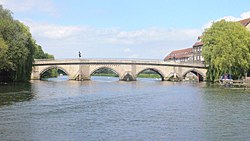Huntingdon
| Huntingdon | |
| Huntingdonshire | |
|---|---|
 Huntingdon town centre | |
| Location | |
| Grid reference: | TL245725 |
| Location: | 52°20’11"N, 0°10’18"W |
| Data | |
| Population: | 19,830 |
| Post town: | Huntingdon |
| Postcode: | PE29 |
| Dialling code: | 01480 |
| Local Government | |
| Council: | Huntingdonshire |
| Parliamentary constituency: |
Huntingdon |
Huntingdon is the county town of Huntingdonshire. It stands in the middle of the county on the River Great Ouse, one of the three towns in the county so to do.
The historic town centre is now clasped inside a ring-road, the High Street with many charming old houses, shops and coaching-inns, running down to the riverside. Away from the High Street and over the forbidding ring-road, is Castle Hill, where Huntingdon Castle once stood, now used for recreation and for several summertime community events. From here too one may cross the river onto Portholme, the largest grass meadow in the land, an island between the streams of the Great Ouse.
Huntingdon's position and prosperity have derived form its standing at a meeting point of several ways; historically the Great North Road between London and Edinburgh, the east-west road between the east coat ports and Cambridge to the Midlands (as far back as the Roman Via Devana) and the river-borne traffic of the Great Ouse. Now it stands where the A1 meets the A14 and the London-Edinburgh rail line.
The town has a well-preserved mediaeval bridge that used to serve as the main route of the Great North Road over the river. The bridge only ceased to be the sole crossing point to Godmanchester in 1975, with the advent of what is now the A14 bypass.
The George Hotel is the grandest inn standing in the town from the great days of the coaching inns. It has kept its original open courtyard, in which a Shakespeare play is performed each summer.
Huntingdon is a market town. It received its first charter from King John in 1205. It is known as the birthplace in 1599 of Oliver Cromwell.

History
Huntingdon was founded during the Anglo-Saxon period. In the Viking age it became a Danish stronghold until 921, when Edward the Elder took the submission of the town and the lands it controlled; presumed to be the origin of Huntingdonshire.
The town's valuable trading position was secured by Huntingdon Castle, long since demolished. The site is now a Scheduled Ancient Monument, and is home to a beacon used to commemorate national events.
The town prospered as a bridging point of the River Great Ouse and as a market town. In the 18th and 19th centuries the coaching inns opened to serve the stage coaches and carriages passing through on the major routes the town commanded.
On 25 April 1599 Oliver Cromwell was born in a house on Huntingdon High Street. His birthday is now the county day, "Huntingdonshire Day", on which to recall that "a man of Huntingdonshire might rise to the highest, for good or ill"[1]
Original historical documents relating to Huntingdon, including the original borough charter of 1205, are held by the County Record Office in Huntingdon.[2]
Between the railway station and the old hospital building stands a cannon. In the 1990s this replica cannon was installed to replace an original cannon brought home from the Crimean War and which stood until the Second World War, when it was scrapped for the war effort.
Portholme
Between Godmanchester, Huntingdon and Brampton lies England's largest meadow, Portholme.[3] Portholme meadow is of around 257 acres and contains many rare species of grass, flowers and dragonfly, it is the only known habitat of the marsh dandelion[4] in Britain. It also acts as a huge natural reservoir for holding excess water in times of flood enabling the river to be run off more slowly, thereby helping to prevent flooding of nearby towns.
Portholme has also served as a horse race course and centre for early aviation.
About the town
Huntingdon stands on the north bank of the River Great Ouse, opposite Godmanchestereastward lies the town of St Ives and a little to the west is the village of Brampton.
Outside the town is Huntingdon Racecourse.

There are 3 RAF bases within 4 miles of the town: RAF Brampton, once home to Headquarters RAF Support Command and now part of the Defence Logistics Organisation; RAF Wyton, once a major flying station but now also part of the DLO; and RAF Alconbury currently occupied by the United States Air Force.
Churches
Huntingdon was once renowned for the number of its churches. Fittingly for the town of Cromwell, there are several free churches, and four of the Church of England:
- Church of England:Huntingdon Churches
- All Saints' (next to the Market Square)
- St Mary's
- St Barnabas (on the Oxmoor estate)
- All Saints', Hartford.
- Huntingdon Free Church [www.huntingdon-free-church.org.uk/]
- Huntingdonshire Community Church
- Methodist Church (High Street)
- Trinity Free Church, Desborough Road
- Salvation Army
References
- ↑ The Huntingdonshire Declaration
- ↑ http://www.cambridgeshire.gov.uk/leisure/archives/visiting/crohuntingdon.htm County Record Office
- ↑ Town Council information - Portholme huntingdon-town.info
- ↑ http://caliban.mpiz-koeln.mpg.de/~stueber/lindman/559.jpg caliban.mpiz-koeln.mpg.de